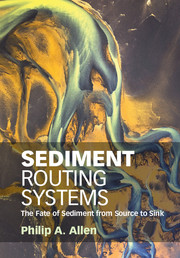Book contents
- Frontmatter
- Contents
- Preface
- Part I A Global View of Sediment Routing Systems
- Part II The Segments of Sediment Routing Systems
- 4 The Catchment-Fluvial Segment
- 5 The Continental Shelf Segment
- 6 The Deep Marine Segment
- Part III The Functioning of Sediment Routing Systems
- Part IV The Stratigraphic Record of Sediment Routing Systems
- References
- Index
4 - The Catchment-Fluvial Segment
from Part II - The Segments of Sediment Routing Systems
Published online by Cambridge University Press: 03 October 2017
- Frontmatter
- Contents
- Preface
- Part I A Global View of Sediment Routing Systems
- Part II The Segments of Sediment Routing Systems
- 4 The Catchment-Fluvial Segment
- 5 The Continental Shelf Segment
- 6 The Deep Marine Segment
- Part III The Functioning of Sediment Routing Systems
- Part IV The Stratigraphic Record of Sediment Routing Systems
- References
- Index
Summary
Sediment routing systems consist of one or more morphodynamic zones within which a coherent set of sediment transport processes operate. These morphodynamic zones, or segments, are genetically related and dynamically connected, since sediment is transferred across their boundaries in a cascade from source to sink. Sømme et al. (2009) proposed a framework where source-to-sink systems may comprise up to three segments:
1. Catchment-fluvial segment, which includes the source region of sediment and the river system connecting the catchment to the ocean, lake or endorheic basin. The morphology and dynamics of this segment are characterised by parameters describing the catchment area, the maximum elevation of the headwaters, the length of the main catchment trunk stream, the water discharge and the sediment load, all of which are impacted by tectonic history of uplift and subsidence, climate, vegetation and bedrock lithologies. Some areas acting as sediment sources may be glaciated. The sediment released from ice sheets and valley glaciers varies according to thermal regime. Sediment is dispersed at the base, within and above the ice mass, as well as by icebergs, and is commonly reworked on the continental shelf and transported to the deep sea by gravity flow processes.
2. Continental shelf segment, which is separated from the fluvial sediment conveyor by the complex dynamics of the coast and is highly susceptible to changes in sea level. Processes on the shelf determine sediment storage potential and the export of particulate sediment to the deep sea. Shelves vary in their width, slope and water depth at the shelfslope break, the extent to which canyons incise towards the coast, and the complex dynamics of river plumes, waves, tides and geostrophic flows in driving sediment transport.
3. Deep marine segment, comprising the continental slope and deep basin floor. The continental slope is the fully subaqueous, overall progradational slope constructed from the spilling over the shelf of primarily suspended sediment. The continental slope varies in bathymetric gradient, slope length and amplitude, dependent on the distribution of tectonic subsidence and sediment supply. The basin floor is the absorbing state in deep water, receiving sediment primarily from gravity-driven debris flows and turbidity currents travelling down canyons incised into the continental slope and from deep ocean currents in the form of contourite drifts. The amount of sediment bypassing the shelf en route to the deep sea varies strongly from close to nil to more than 90%.
- Type
- Chapter
- Information
- Sediment Routing SystemsThe Fate of Sediment from Source to Sink, pp. 83 - 130Publisher: Cambridge University PressPrint publication year: 2017



